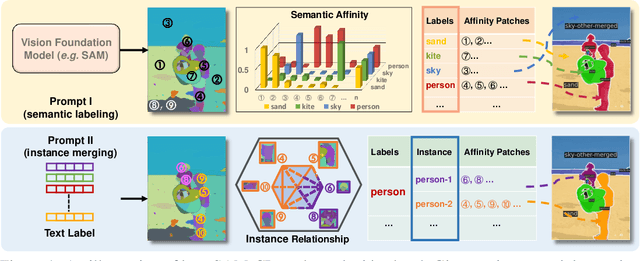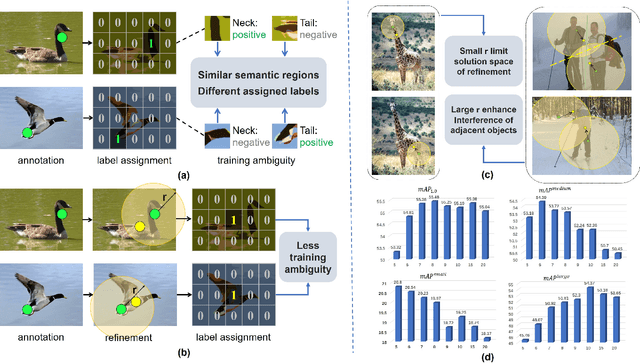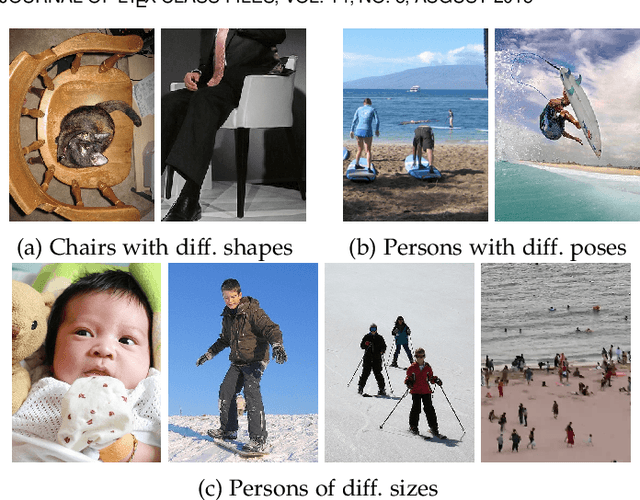Xuehui Yu
AD^2-Bench: A Hierarchical CoT Benchmark for MLLM in Autonomous Driving under Adverse Conditions
Jun 11, 2025Abstract:Chain-of-Thought (CoT) reasoning has emerged as a powerful approach to enhance the structured, multi-step decision-making capabilities of Multi-Modal Large Models (MLLMs), is particularly crucial for autonomous driving with adverse weather conditions and complex traffic environments. However, existing benchmarks have largely overlooked the need for rigorous evaluation of CoT processes in these specific and challenging scenarios. To address this critical gap, we introduce AD^2-Bench, the first Chain-of-Thought benchmark specifically designed for autonomous driving with adverse weather and complex scenes. AD^2-Bench is meticulously constructed to fulfill three key criteria: comprehensive data coverage across diverse adverse environments, fine-grained annotations that support multi-step reasoning, and a dedicated evaluation framework tailored for assessing CoT performance. The core contribution of AD^2-Bench is its extensive collection of over 5.4k high-quality, manually annotated CoT instances. Each intermediate reasoning step in these annotations is treated as an atomic unit with explicit ground truth, enabling unprecedented fine-grained analysis of MLLMs' inferential processes under text-level, point-level, and region-level visual prompts. Our comprehensive evaluation of state-of-the-art MLLMs on AD^2-Bench reveals accuracy below 60%, highlighting the benchmark's difficulty and the need to advance robust, interpretable end-to-end autonomous driving systems. AD^2-Bench thus provides a standardized evaluation platform, driving research forward by improving MLLMs' reasoning in autonomous driving, making it an invaluable resource.
P2Object: Single Point Supervised Object Detection and Instance Segmentation
Apr 10, 2025Abstract:Object recognition using single-point supervision has attracted increasing attention recently. However, the performance gap compared with fully-supervised algorithms remains large. Previous works generated class-agnostic \textbf{\textit{proposals in an image}} offline and then treated mixed candidates as a single bag, putting a huge burden on multiple instance learning (MIL). In this paper, we introduce Point-to-Box Network (P2BNet), which constructs balanced \textbf{\textit{instance-level proposal bags}} by generating proposals in an anchor-like way and refining the proposals in a coarse-to-fine paradigm. Through further research, we find that the bag of proposals, either at the image level or the instance level, is established on discrete box sampling. This leads the pseudo box estimation into a sub-optimal solution, resulting in the truncation of object boundaries or the excessive inclusion of background. Hence, we conduct a series exploration of discrete-to-continuous optimization, yielding P2BNet++ and Point-to-Mask Network (P2MNet). P2BNet++ conducts an approximately continuous proposal sampling strategy by better utilizing spatial clues. P2MNet further introduces low-level image information to assist in pixel prediction, and a boundary self-prediction is designed to relieve the limitation of the estimated boxes. Benefiting from the continuous object-aware \textbf{\textit{pixel-level perception}}, P2MNet can generate more precise bounding boxes and generalize to segmentation tasks. Our method largely surpasses the previous methods in terms of the mean average precision on COCO, VOC, SBD, and Cityscapes, demonstrating great potential to bridge the performance gap compared with fully supervised tasks.
Segment Any-Quality Images with Generative Latent Space Enhancement
Mar 16, 2025



Abstract:Despite their success, Segment Anything Models (SAMs) experience significant performance drops on severely degraded, low-quality images, limiting their effectiveness in real-world scenarios. To address this, we propose GleSAM, which utilizes Generative Latent space Enhancement to boost robustness on low-quality images, thus enabling generalization across various image qualities. Specifically, we adapt the concept of latent diffusion to SAM-based segmentation frameworks and perform the generative diffusion process in the latent space of SAM to reconstruct high-quality representation, thereby improving segmentation. Additionally, we introduce two techniques to improve compatibility between the pre-trained diffusion model and the segmentation framework. Our method can be applied to pre-trained SAM and SAM2 with only minimal additional learnable parameters, allowing for efficient optimization. We also construct the LQSeg dataset with a greater diversity of degradation types and levels for training and evaluating the model. Extensive experiments demonstrate that GleSAM significantly improves segmentation robustness on complex degradations while maintaining generalization to clear images. Furthermore, GleSAM also performs well on unseen degradations, underscoring the versatility of our approach and dataset.
ClickTrack: Towards Real-time Interactive Single Object Tracking
Nov 24, 2024



Abstract:Single object tracking(SOT) relies on precise object bounding box initialization. In this paper, we reconsidered the deficiencies in the current approaches to initializing single object trackers and propose a new paradigm for single object tracking algorithms, ClickTrack, a new paradigm using clicking interaction for real-time scenarios. Moreover, click as an input type inherently lack hierarchical information. To address ambiguity in certain special scenarios, we designed the Guided Click Refiner(GCR), which accepts point and optional textual information as inputs, transforming the point into the bounding box expected by the operator. The bounding box will be used as input of single object trackers. Experiments on LaSOT and GOT-10k benchmarks show that tracker combined with GCR achieves stable performance in real-time interactive scenarios. Furthermore, we explored the integration of GCR into the Segment Anything model(SAM), significantly reducing ambiguity issues when SAM receives point inputs.
Click; Single Object Tracking; Video Object Segmentation; Real-time Interaction
Nov 20, 2024



Abstract:Single object tracking(SOT) relies on precise object bounding box initialization. In this paper, we reconsidered the deficiencies in the current approaches to initializing single object trackers and propose a new paradigm for single object tracking algorithms, ClickTrack, a new paradigm using clicking interaction for real-time scenarios. Moreover, click as an input type inherently lack hierarchical information. To address ambiguity in certain special scenarios, we designed the Guided Click Refiner(GCR), which accepts point and optional textual information as inputs, transforming the point into the bounding box expected by the operator. The bounding box will be used as input of single object trackers. Experiments on LaSOT and GOT-10k benchmarks show that tracker combined with GCR achieves stable performance in real-time interactive scenarios. Furthermore, we explored the integration of GCR into the Segment Anything model(SAM), significantly reducing ambiguity issues when SAM receives point inputs.
SAM-CP: Marrying SAM with Composable Prompts for Versatile Segmentation
Jul 23, 2024



Abstract:The Segment Anything model (SAM) has shown a generalized ability to group image pixels into patches, but applying it to semantic-aware segmentation still faces major challenges. This paper presents SAM-CP, a simple approach that establishes two types of composable prompts beyond SAM and composes them for versatile segmentation. Specifically, given a set of classes (in texts) and a set of SAM patches, the Type-I prompt judges whether a SAM patch aligns with a text label, and the Type-II prompt judges whether two SAM patches with the same text label also belong to the same instance. To decrease the complexity in dealing with a large number of semantic classes and patches, we establish a unified framework that calculates the affinity between (semantic and instance) queries and SAM patches and merges patches with high affinity to the query. Experiments show that SAM-CP achieves semantic, instance, and panoptic segmentation in both open and closed domains. In particular, it achieves state-of-the-art performance in open-vocabulary segmentation. Our research offers a novel and generalized methodology for equipping vision foundation models like SAM with multi-grained semantic perception abilities.
Skill-aware Mutual Information Optimisation for Generalisation in Reinforcement Learning
Jun 07, 2024



Abstract:Meta-Reinforcement Learning (Meta-RL) agents can struggle to operate across tasks with varying environmental features that require different optimal skills (i.e., different modes of behaviours). Using context encoders based on contrastive learning to enhance the generalisability of Meta-RL agents is now widely studied but faces challenges such as the requirement for a large sample size, also referred to as the $\log$-$K$ curse. To improve RL generalisation to different tasks, we first introduce Skill-aware Mutual Information (SaMI), an optimisation objective that aids in distinguishing context embeddings according to skills, thereby equipping RL agents with the ability to identify and execute different skills across tasks. We then propose Skill-aware Noise Contrastive Estimation (SaNCE), a $K$-sample estimator used to optimise the SaMI objective. We provide a framework for equipping an RL agent with SaNCE in practice and conduct experimental validation on modified MuJoCo and Panda-gym benchmarks. We empirically find that RL agents that learn by maximising SaMI achieve substantially improved zero-shot generalisation to unseen tasks. Additionally, the context encoder equipped with SaNCE demonstrates greater robustness to reductions in the number of available samples, thus possessing the potential to overcome the $\log$-$K$ curse.
Causal prompting model-based offline reinforcement learning
Jun 03, 2024Abstract:Model-based offline Reinforcement Learning (RL) allows agents to fully utilise pre-collected datasets without requiring additional or unethical explorations. However, applying model-based offline RL to online systems presents challenges, primarily due to the highly suboptimal (noise-filled) and diverse nature of datasets generated by online systems. To tackle these issues, we introduce the Causal Prompting Reinforcement Learning (CPRL) framework, designed for highly suboptimal and resource-constrained online scenarios. The initial phase of CPRL involves the introduction of the Hidden-Parameter Block Causal Prompting Dynamic (Hip-BCPD) to model environmental dynamics. This approach utilises invariant causal prompts and aligns hidden parameters to generalise to new and diverse online users. In the subsequent phase, a single policy is trained to address multiple tasks through the amalgamation of reusable skills, circumventing the need for training from scratch. Experiments conducted across datasets with varying levels of noise, including simulation-based and real-world offline datasets from the Dnurse APP, demonstrate that our proposed method can make robust decisions in out-of-distribution and noisy environments, outperforming contemporary algorithms. Additionally, we separately verify the contributions of Hip-BCPDs and the skill-reuse strategy to the robustness of performance. We further analyse the visualised structure of Hip-BCPD and the interpretability of sub-skills. We released our source code and the first ever real-world medical dataset for precise medical decision-making tasks.
CPR++: Object Localization via Single Coarse Point Supervision
Jan 30, 2024



Abstract:Point-based object localization (POL), which pursues high-performance object sensing under low-cost data annotation, has attracted increased attention. However, the point annotation mode inevitably introduces semantic variance due to the inconsistency of annotated points. Existing POL heavily rely on strict annotation rules, which are difficult to define and apply, to handle the problem. In this study, we propose coarse point refinement (CPR), which to our best knowledge is the first attempt to alleviate semantic variance from an algorithmic perspective. CPR reduces the semantic variance by selecting a semantic centre point in a neighbourhood region to replace the initial annotated point. Furthermore, We design a sampling region estimation module to dynamically compute a sampling region for each object and use a cascaded structure to achieve end-to-end optimization. We further integrate a variance regularization into the structure to concentrate the predicted scores, yielding CPR++. We observe that CPR++ can obtain scale information and further reduce the semantic variance in a global region, thus guaranteeing high-performance object localization. Extensive experiments on four challenging datasets validate the effectiveness of both CPR and CPR++. We hope our work can inspire more research on designing algorithms rather than annotation rules to address the semantic variance problem in POL. The dataset and code will be public at github.com/ucas-vg/PointTinyBenchmark.
P2Seg: Pointly-supervised Segmentation via Mutual Distillation
Jan 18, 2024Abstract:Point-level Supervised Instance Segmentation (PSIS) aims to enhance the applicability and scalability of instance segmentation by utilizing low-cost yet instance-informative annotations. Existing PSIS methods usually rely on positional information to distinguish objects, but predicting precise boundaries remains challenging due to the lack of contour annotations. Nevertheless, weakly supervised semantic segmentation methods are proficient in utilizing intra-class feature consistency to capture the boundary contours of the same semantic regions. In this paper, we design a Mutual Distillation Module (MDM) to leverage the complementary strengths of both instance position and semantic information and achieve accurate instance-level object perception. The MDM consists of Semantic to Instance (S2I) and Instance to Semantic (I2S). S2I is guided by the precise boundaries of semantic regions to learn the association between annotated points and instance contours. I2S leverages discriminative relationships between instances to facilitate the differentiation of various objects within the semantic map. Extensive experiments substantiate the efficacy of MDM in fostering the synergy between instance and semantic information, consequently improving the quality of instance-level object representations. Our method achieves 55.7 mAP$_{50}$ and 17.6 mAP on the PASCAL VOC and MS COCO datasets, significantly outperforming recent PSIS methods and several box-supervised instance segmentation competitors.
 Add to Chrome
Add to Chrome Add to Firefox
Add to Firefox Add to Edge
Add to Edge